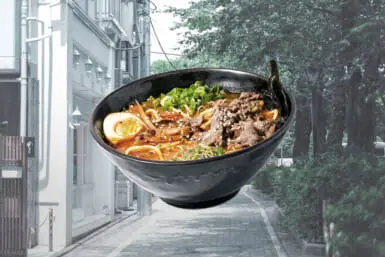with Donna Sweeny
The Spices of India
Three years ago, an Indian hotel chain invited ten of the leading French chefs to India to tour the country, visiting live cities with distinctly different cooking styles. The chefs were accompanied by food critics, including Craig Claiborne of The New York Times and New York Magazine‘s Gael Greene. The purpose of this trip was to familiarize the chefs with Indian spices and perhaps to inspire them to include these spices and spice mixtures in the new styles of cooking such as Nouvelle Cuisine and Cuisine Naturelle.
As the chefs made their way from Delhi to Goa, sampling the specialties of each city, they must have been astounded — as so many visitors are — by the richness and variety of the spices used.
The vast subcontinent of India holds a great diversity of cultures, races and religions and this leads inevitably to differences in diet and food preparation; there is, then, no “typical” Indian cuisine. Whatever the regional differences are, however, it would seem that all Indians are geniuses when it comes to using spices. Most of their spices — such as black pepper, cinnamon, cloves and nutmeg—are probably familiar to you. Less familiar perhaps are cardamom, coriander, cumin, fennugreek, mace, saffron and tumeric.
Cardamom, a member of the ginger family, is native to India. It has a pungent, pleasing aroma and has been used in the manufacture of cosmetics and perfumes from the time of the ancient Greeks to the present day. Cardamom is used principally in making pastries, custards and breads and to flavor curries.
Coriander, both in seed and leaf form, is used extensively in Indian cooking. Whole coriander seeds are an important ingredient in marinades and meat curries: its ground seeds add a slight lemon-like flavor to yogurt, sauces and meat dishes. Fresh coriander leaves, sometimes called “Chinese parsley,” are a delicious addition to salads and soups. Another member of the parsley family, cumin, is an aromatic spice with a strong flavor. A main ingredient in curries and chutneys, it can also be used in marinades and is particularly delicious with lamb.
Fenugreek seeds are used both whole and ground in many Indian vegetable dishes; they have a bitter taste and a strong aroma similar to celery. Mace, the dried outer covering of nutmeg, has a delicate flavor; its subtlety makes it a versatile spice which is often used in the preparation of meats and vegetables as well as desserts.
Saffron, the world’s most expensive spice, has a long and romantic history. It takes about 13,000 crocus stigmas (which must, of course, be gathered by hand) to produce one ounce of saffron — no wonder that it costs as much as gold! Saffron has long been used as a medicine and a dye as well as in cooking. It was favored by Cleopatra as a cosmetic ingredient and the Greeks and Romans used it to scent their theaters and public meeting places. Today, most saffron is grown in Spain, but there are still abundant saffron fields in Kashmir at the foothills of the Himalaya Mountains. Saffron is used primarily in rice dishes as well as in the preparation of meats and vegetables.
Another spice popular for its dyeing properties is tumeric; with its distinctive bright yellow color, it is often used to dye monks’ robes. In the kitchen, it adds fragrance and color to curries and rice dishes.
In India, spices are mixed for each dish at the time of preparation and usually cooked along with the food. Garam masala is the exception. A mixture of several spices such as cardamom, cinnamon, cumin, mace, nutmeg and cloves, it is usually added just before serving and often sprinkled on top. Most households have their own treasured recipes for this spice mixture.
Since spices quickly lose much of their flavor and aroma, it is best to buy them whole and grind (hem yourself, as you need them, in an electric coffee grinder, food processor or using a mortar and pestle. Spices should be kept away from heat and sunlight (not over the stove!)
The use of these spices is not, of course, limited to Indian cooking. They will add zest and interest to almost any kind of cuisine, so be creative and experiment. One thing is sure — your kitchen will smell wonderful!
Lamb Curry (serves 4)
- 1 large tomato
- 4 tablespoons ghee or vegetable oil*
- 1 large onion, sliced
- 2 cloves garlic, pressed
- 1 1/4 pounds leg of lamb, cut into bite-sized cubes
- 3 cups yogurt
- 1 1/2 teaspoons cardamom
- 1 teaspoon cayenne pepper
- 1 tablespoon coriander
- 1 teaspoon cumin seed, crushed
- 2 teaspoons ground ginger
- 1 teaspoon paprika
- 1 teaspoon tumeric
- 6 whole cloves
- 4 tablespoons grated coconut
- Hot rice
- Plunge the tomato into boiling water until the skin splits, about 15 seconds; peel and chop.
- Heat the ghee or vegetable oil in a large skillet and saute the tomato, onion and garlic until the onion is translucent.
- Add the lamb, yogurt and spices; simmer for one hour, stirring occasionally.
- Remove the curry to a serving bowl and sprinkle with grated coconut. Serve with rice.
* Indian food is traditionally cooked in ghee, a kind of clarified butter which can easily be made at home by heating butter over very low heat. When the solids separate and begin to sink to the bottom of the pan, pour the butter into a jar through a strainer lined with cheesecloth; discard the solids.
Cooking expert Madhur Jaffrey (An Invitation to Indian Cooking, Random House, New York) maintains that while clarified butter is the traditional cooking medium, its cost can be prohibitive and its taste very rich. She says that today’s cooks favor another kind of ghee which is a type of vegetable shortening. This can easily be purchased in the larger Tokyo supermarkets. In all of these recipes, however, vegetable oil may be substituted for ghee.
Chicken in Yogurt (serves 4)
- 8 ounces yogurt
- 3/4 cup chicken broth
- 8 tablespoons vegetable oil
- 4 cups coarsely chopped onions
- 4 chicken breasts, skinned, boned and cut into bite-sized pieces
- 2 cloves garlic, pressed
- 1/2 teaspoon ground cardamom
- 1 teaspoon ground ginger
- 1/4 teaspoon cayenne pepper
- Combine the yogurt and chicken broth in a bowl, mix thoroughly and set aside.
- In a deep saucepan, heat 4 tablespoons of vegetable oil and saute the onions until they are translucent. Remove the onions and set aside.
- Add 4 tablespoons of oil to the saucepan and brown the chicken pieces on all sides.
- Lower the heat and add the garlic and spices to the saucepan. Slowly stir in the yogurt/chicken broth mixture. Put the onions back in the saucepan, cover and simmer for 20 minutes.
Yogurt Mint Dip
Yogurt figures heavily in Indian cuisine as an important protein source. It is often used as a marinade and its refreshing taste makes it an excellent foil for spicy dishes when it is used as a sauce. Yogurt Mint Dip is a delicious accompaniment to grilled meats, particularly lamb.
(makes about 1 1/2 cups)
- 8 ounces yogurt
- 2 tablespoons dried spearmint
- 1 teaspoon sugar
- 1/2 teaspoon cayenne pepper
- Combine all ingredients in a bowl and refrigerate until throughly chilled, about two hours.
Coconut Rice Dessert (serves 4)
- 1 cup rice at room temperature
- 2 tablespoons raisins
- 1/2 cup grated coconut
- 1/2 teaspoon ground cardamom
- 1/3 cup ground almonds
- Combine the rice, raisins, coconut and cardamom, mixing thoroughly.
- Spoon into four individual dessert dishes and sprinkle with ground almonds.









